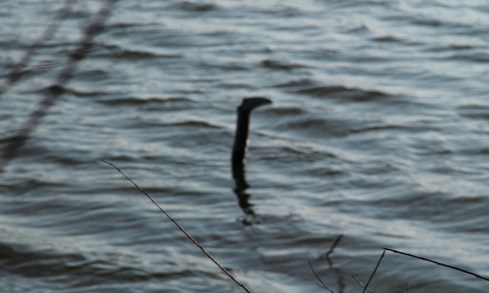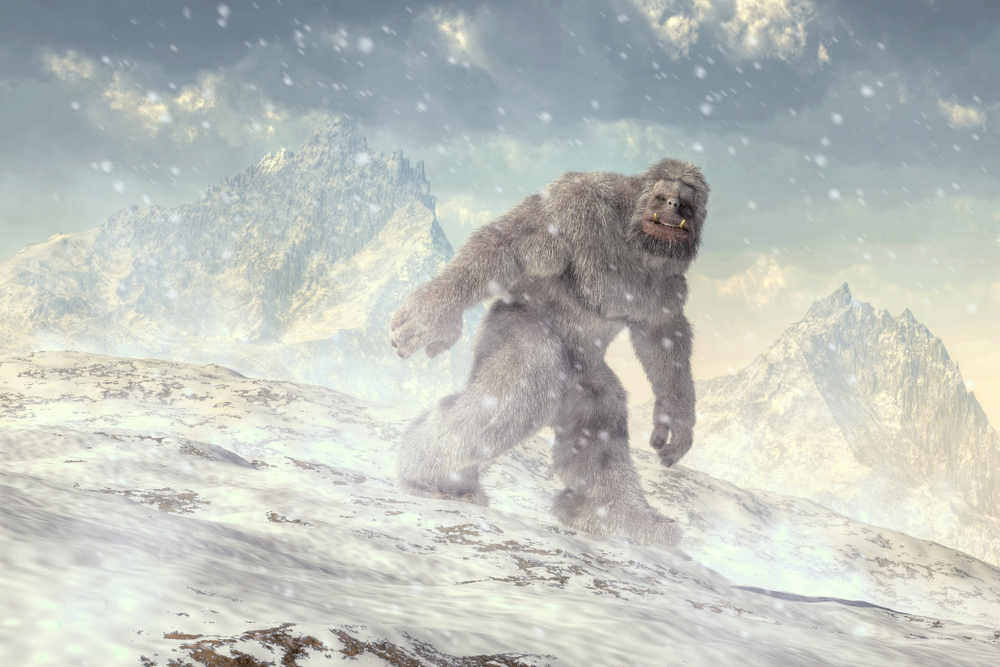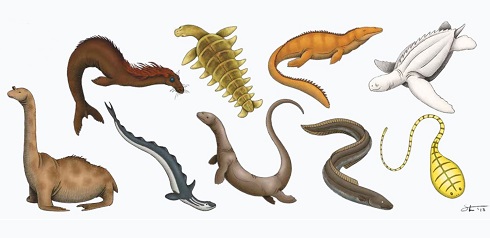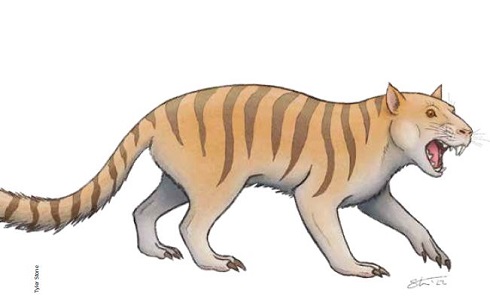A cultural phenomenon

Palaeontologist Darren Naish explains why the unscientific field of ‘cryptozoology’ can still tell us a lot about how humans see nature
September 12th 2022
Bigfoot. Nessie. Yeti. Sea monsters. All terms mostly avoided by biologists, and all deemed synonymous with pseudoscience, pop culture and wishful thinking more than biology. Throughout history anecdotes and stories have described large animals, often considered monstrous or frightening, that don’t conform to species recognised by science.
These supposed animals are ‘cryptids’, and the field of study devoted to them is cryptozoology, the ‘science of hidden animals’. Cryptozoology is not regarded as mainstream science. But while Nessie and the Yeti are likely not real flesh-and-blood animals awaiting zoological discovery, an argument can be made that there might still be something worthy of study here. Can cryptozoology – or a modified version of it – be salvaged?
My interest in cryptozoology started when I was an enthusiastic young naturalist smitten with the idea that anecdotal evidence marshalled in support of certain cryptids was persuasive. While studying the subject during the 1990s I held the view that long-bodied water monsters reported by eyewitnesses might be descriptions of encounters with unusual long-bodied whales. However, I couldn’t square this with the fact that descriptions provide these cryptids with whiskers, ears or horns, scaly skin, serrated backs and humps. It was as if people were describing all manner of different objects or providing the creatures with attributes you might imagine a water monster to have.
Meanwhile, writings on the topic would amalgamate reports as if they pertained to the same thing. In the case of water monsters, the accounts likely describe observations of swimming deer, seals, water birds, large fish, floating wood, unusual waves and wakes, and boats. I began to think that it was naïve and literalist to regard cryptids as unknown animals.
This view was hardly novel. Folklorists such as Michel Meurger and Claude Gagnon emphasised in their 1988 book, Lake Monster Traditions: A Cross-Cultural Analysis, that a major part of belief in cryptids comes from the cultural setting of those observing and sharing their encounters. Big, deep lakes, for example, are imagined in several European cultures to be inhabited by monsters that combine the traits of monstrous fish and predatory ‘water horses’.
Physical evidence that might support the existence of these creatures has never been obtained, yet the creatures are ubiquitous in the relevant cultures, even travelling with the peoples concerned when they move to new lands. What I think these examples show is that cryptids are ‘cultural archetypes’ embedded in the way people imagine the world. So familiar is their place within this view of the world that they’re expected in the appropriate locations.
Cultural memes
If cryptids exist in the cultural realm more than the zoological one, it follows that the sorts of cryptids suspected to exist should follow trends in popular culture. Among the best examples of this is mokele-mbembe, a mythical Congolese water monster linked by cryptozoologists to sauropod dinosaurs. This ‘sauropod’ version of the mokele-mbembe emerged during the early 1900s, a time when sauropod skeletons were being installed in the museums of New York, London, Paris and elsewhere. As a result, mokele-mbembe – portrayed as swamp dwelling and amphibious – is a cultural anachronism, closely mimicking the look and behaviour of sauropods favoured at the time, which has since been proven to be inaccurate.

Winged monsters of the tropics – claimed in cryptozoological writing to perhaps be modern pterosaurs – are similarly anachronistic, recalling the pterosaurs of the 1960s adventure fantasy One Million Years B.C. more than those of the palaeontological literature. A cryptozoological tradition in which sea and lake monsters are interpreted as post-Cretaceous plesiosaurs is dependent on a 19th century view that these animals swam with erect necks. The cryptozoological literature functions in part as a ‘museum’ of ideas and hypotheses once disseminated in popular culture.
Monster time line
Could people’s familiarity with prehistoric animals explain their observations of certain monsters? In 2019, statistical ecologist Charles Paxton and I performed a study that aimed to test this idea, analysing 1,688 sea monster accounts dating back to the 1600s.
We found sea monsters were predominantly described as serpent or snake-like prior to the 1850s. However, beyond this they were increasingly described as long necked and compared to plesiosaurs, a group of animals unveiled to science in 1824 and made popular to the public during the 1840s and 1850s. Rather than arguing that certain sea monster species had gone into decline and been replaced by evolutionarily younger forms (a claim that has actually been made in cryptozoological writings), our conclusion is that expectations of what sea monsters are like has been, and still is, based on images familiar in popular culture.
This is in keeping with the view that cryptozoology is not a subset of biological science. Rather than seeing a biological phenomenon, we’re seeing a psychological, sociocultural one, formed from intertwined strands. These involve the way in which people perform as eyewitnesses and data recallers, how people’s expectations shape what they think they see, and the cultural setting of the reporter.
This ‘cultural’ view of cryptozoology is not in keeping with the ‘flesh and blood’ or ‘pelts and paws’ view preferred by advocates of the field, and for that reason it’s seen as a highly sceptical position, if not a cynical one. Ultimately it might mean that we should abandon the term cryptozoology altogether, since there may be little to no ‘zoology’ at the bottom of it.
Self-styled cryptozoologists are an interesting lot and some favour an aggressive response to sceptical approaches. It’s not uncommon – as a sceptical commentator interacting with cryptozoologists – to be accused of being closed-minded or not very bright, albeit in more colourful terms. More problematic are communications that liken sceptics to fascists, or which accuse my colleagues and me of outright lying. Several studies have found an interest in cryptozoology to be connected to fringe beliefs such as creationism and conspiracy theory, and it is not difficult to find anti-scientific tones in sectors of the cryptozoological community.
However, cryptozoologists themselves aren’t all bad. Speaking as someone who knows many of the individuals in person and has attended their conferences and fieldwork events, I object to the idea that cryptozoologists as a whole can be tarred with the same brush. It is not true that everyone interested in mystery animal research is misguided, woefully naïve or anti-scientific. Honest scepticism, a commitment to data collection and respect for the scientific process are present in the community too.
 Belgian zoologist Bernard Heuvelmans used sightings to create nine categories of sea monster, from the ‘merhorse’ (top left) to the ‘father-of-all-turtles’ and snake-like yellow belly (right top and bottom). Illustration by Tyler Stone.
Belgian zoologist Bernard Heuvelmans used sightings to create nine categories of sea monster, from the ‘merhorse’ (top left) to the ‘father-of-all-turtles’ and snake-like yellow belly (right top and bottom). Illustration by Tyler Stone.
Speculative zoology
The idea that cryptids are somehow surviving individuals from a prehistoric species is a well-known feature of cryptozoology, but cryptozoological writings are often rife with an additional layer of speculation. When imagined in detail as ‘real’ animals, cryptids often end up as radically novel members of their respective groups.
As an example, one of the best-known cryptozoological popularisers – Belgian zoologist Bernard Heuvelmans (1916-2001) – interpreted Eurasian ape-men as nocturnal Neanderthals that had evolved a suite of novelties that made them very different from the Neanderthals known from fossil evidence. Heuvelmans also posited that certain African water monsters were the aquatic descendants of sabre-toothed cats and that some sea monsters were armour-plated, multi-finned basilosaurids (a group of fossil whales).
The existence of giant, long-necked seals and post-Cretaceous plesiosaurs with inflatable humps and breathing tubes has also been popular in the cryptozoological literature. These intellectual exercises belong to the field termed speculative zoology, a mostly frivolous area in which authors make speculations about evolution. This is all fine and good in works of science fiction, but is out of place in supposedly scholarly works that aim to identify unidentified animal species.
Mystery carcasses’, found on beaches and said to be ‘unidentifiable’, are a mainstay of the cryptozoology literature. As a palaeozoologist trained in anatomy and versed in taphonomy, I have often been involved in the identification of carcasses that were the source of cryptozoological interest. In July 2008 a mammal carcass was discovered at Montauk on Long Island, New York. Its grey, mostly naked skin and curved ‘beak’ led to a total internet meltdown. Dubbed the ‘Montauk Monster’, it was declared a new kind of animal – perhaps an alien or lab experiment.
From its hands and teeth I identified it as a decomposing raccoon, an identity now universally recognised as correct. Numerous other examples of this sort of thing could be recounted – mystery carcasses are typically only mysteries as long as they are not examined by experts. Once examined by the right people they tend to become less mysterious, if not mundane.
Should, then, cryptozoology be denounced as pseudoscience? Some argue that it should and that its practitioners are only pretending to ‘do science’. Those in favour of this view argue that cryptozoology should be considered akin to belief in the paranormal and that it functions as the thin end of the wedge when it comes to an anti-scientific view of the world.
The term ‘cryptozoology’ has in fact been undergoing a transformation of meaning. The ‘traditional version’ of cryptozoology at least focuses on creatures alleged to be ‘normal’ animals, even if they are terrifying, anachronistic, phylogenetically novel and scientifically unrecognised. However, social media groups, TV shows, YouTube videos, podcasts and books using the term cryptozoology today can be decidedly non-zoological. Bigfoot looms large, for sure, but among the current superstars of cryptozoology are Chupacabra, an alien-like vampirous creature; and Dogman, a seven-foot North American werewolf with a canine head on a human torso.
In addition, discussions about cryptozoology in the popular sphere now overlap with those on UFOs, demons and paranormal phenomena. All are suspected by aficionados to be related branches of the same big picture. What we’re seeing here is a disregard for (or ignorance of) the zoological roots of cryptozoology, and a downhill slide to belief in a demon-haunted world. Archaeologist and anthropologist Jeb Card terms these overlapping beliefs the Paranormal Unified Field Theory, or PUFT. It’s on the rise and swallowing cryptozoology alive.
For a time there was a concerted effort among those seriously interested in cryptozoology to have the field accepted as part of mainstream biology. We can say today that this attempted paradigm shift has failed. This isn’t due to lack of interest or involvement from scientists, but to lack of supporting evidence and realisation that descriptions of cryptids are better explained in a cultural setting than a biological one.
If, however, cryptozoology – even if it is considered part of the PUFT – is more about culture, we’re still looking at something worthy of study. Animals are involved, but the field is more about how people imagine animals that aren’t real: animals that exist as cultural archetypes, not flesh-and-blood species awaiting discovery. Maybe cryptozoology is dead. But long live cryptozoology.
Darren Naish is a palaeozoological researcher, author, editor, consultant and lecturer affiliated with the University of Southampton. He writes and produces podcasts for the Tetrapod Zoology blog, and has co-authored two books on cryptozoology and speculative zoology: Cryptozoologicon and All Yesterdays: Unique and Speculative Views of Dinosaurs and Other Prehistoric Animals.
 Since the late 1800s, Australian accounts have described the ‘Queensland tiger’, a large, vicious beast, differing from actual tigers in colour and anatomical detail. The fossil record shows that a group of superficially cat-like marsupials – the thylacoleonids or marsupial lions – once inhabited the country. Perhaps, cryptozoologists suggest, the Queensland tiger is a persisting marsupial lion? In around 1975 a cat-like carcass was discovered close to the Margaret River in Western Australia and nicknamed ‘Jaws’. A short face, striped pelt and peculiar teeth led to suggestions that this might be a modern-day thylacoleonid carcass, a phenomenal claim if true. I subjected Jaws to study in 2012. By analysing tooth anatomy and making appropriate comparisons, I was able to show that it was, in fact, a dead domestic cat. (Illustration by Tyler Stone).
Since the late 1800s, Australian accounts have described the ‘Queensland tiger’, a large, vicious beast, differing from actual tigers in colour and anatomical detail. The fossil record shows that a group of superficially cat-like marsupials – the thylacoleonids or marsupial lions – once inhabited the country. Perhaps, cryptozoologists suggest, the Queensland tiger is a persisting marsupial lion? In around 1975 a cat-like carcass was discovered close to the Margaret River in Western Australia and nicknamed ‘Jaws’. A short face, striped pelt and peculiar teeth led to suggestions that this might be a modern-day thylacoleonid carcass, a phenomenal claim if true. I subjected Jaws to study in 2012. By analysing tooth anatomy and making appropriate comparisons, I was able to show that it was, in fact, a dead domestic cat. (Illustration by Tyler Stone). 

